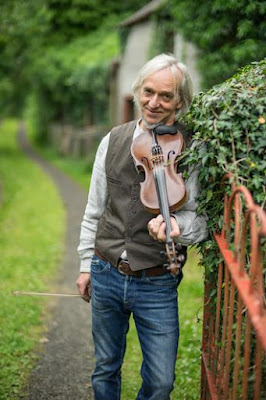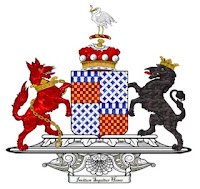THE CHAPMAN BARONETS, OF KILLUA CASTLE, WERE MAJOR LANDOWNERS IN COUNTY WESTMEATH, WITH 9,516 ACRES
The parent stock of this family flourished through several generations, in and near the town of Hinckley, Leicestershire. The branch settled in Ireland was established there by JOHN CHAPMAN and his brother WILLIAM, under the auspices of their first cousin, Sir Walter Raleigh;
Through whose influence John obtained grants of land in County Kerry, which, on the fall of his great patron, he was obliged, from pecuniary difficulties, to dispose of to the 1st Earl of Cork, receiving the large sum, in those days, of £26,400 (about £7 million in 2016) from his lordship.
He lived eight years after this transaction, leaving at his decease, his brother,
WILLIAM CHAPMAN, surviving, who lived for several years afterwards, and left at his decease, an only son,
BENJAMIN CHAPMAN, who entered as a cornet into a cavalry regiment, raised by the Earl of Inchiquin; and obtained, from Cromwell, when Captain Chapman, a grant of a considerable estate in County Westmeath, at Killua, otherwise St Lucy's, formerly a preceptory, or cell, of the knights hospitallers, where he resided during the remainder of his life.
Captain Chapman wedded Anne, daughter of Robert Parkinson, of Ardee, and had two sons, of whom the younger, Thomas, settled in America; and the elder,
WILLIAM CHAPMAN, succeeded his father at Killua.
He married Ismay, daughter of Thomas Nugent; and dying in 1734, was succeeded by his eldest son,
BENJAMIN CHAPMAN, who wedded Anne, daughter of Robert Tighe, by whom he had three sons and two daughters.
He died in 1779, and was succeeded by his eldest son,
BENJAMIN CHAPMAN (c1745-1810), of Killua Castle, MP for Fore, 1772-6, County Westmeath, 1776-83, who was created a baronet in 1782, designated of Killua Castle, County Westmeath, with remainder in default of male issue, to the male descendants of his father.
Sir Benjamin married Miss Anne Lowther; but dying without an heir, in 1810, the title devolved upon his brother,
SIR THOMAS CHAPMAN, 2nd Baronet (1756-1837), who had previously received the honour of Knighthood.
Sir Thomas married, in 1808, Margaret, daughter of James Fetherston, of Bracklin Castle, County Westmeath, and had issue,
MONTAGU LOWTHER, his heir;
Benjamin James;
William.
He was succeeded by his eldest son,
SIR MONTAGU LOWTHER CHAPMAN, 3rd Baronet (1808-1853), of Killua Castle, County Westmeath.
- Sir Montagu Richard Chapman, 5th Baronet (1853–
- Sir Benjamin Rupert Chapman, 6th Baronet (1865–1914);
The 7th Baronet left his wife to live with his daughters' governess, Sarah Junner. The couple did not marry.
Caroline Margaret, wife of Sir Montagu, the 5th Baronet, was sister of the 7th Baronet, Lawrence's father.
She was the last Chapman to live in Killua until her death in 1920. She wrote a fascinating little booklet with the history of the house.
Lawrence did visit Killua once, but it was a few weeks before his death when Killua was already a golf club owned by Mr Hackett.
There is a letter by Lawrence at the Imperial War Museum where he mentions his intention to buy the property back into the family.
Alas, it was never meant to be.
KILLUA CASTLE is situated near Clonmellon, County Westmeath.
The present mansion was built ca 1780 by Sir Benjamin Chapman, 1st Baronet, consisting of a hall, dining room, oval drawing room, breakfast parlour and front and back stairs.
There was also a stable yard, barn and haggard.
From here, the Chapmans administered the surrounding farm lands in the 18th century.
The Castle and its surrounding lands were granted around 1667 to Benjamin Chapman.
On his death the estate passed to his elder son, William; and on William's death in 1734 to his son Benjamin.
Sir Benjamin demolished the original castle.
It passed from him in 1810, by special remainder, to his brother Thomas who, in the early 1820s, commissioned the addition of a large round tower and several other towers, including a library tower, staircase tower and back door tower.
He also completed the castellation and erected the Raleigh obelisk nearby.
When Sir Montagu, 5th Baronet, died childless in 1907, his widow, a cousin, divided the estate between the four legitimate daughters of her brother Sir Thomas, 7th Baronet.
The house and the remaining 1,200 acres of land were sold in 1949.
Until recently, the Castle had become an ivy-clad roofless ruin.
Since 2010, however, Killua Castle has been purchased by a private owner and is undergoing major restoration.
THE OBELISK, erected in 1810 by Sir Thomas Chapman, 2nd Baronet, marks the position where Sir Walter Raleigh planted some of the first potatoes that he imported to Ireland.
The inscription on the obelisk currently reads 'Sir Walter G Raleigh', but there is no other evidence that Raleigh had a middle name, and the 'G' appears to be vandalism added after the original inscription.
The obelisk has been recently restored through a grant from the Irish Georgian Society.
First published in May, 2013.

















